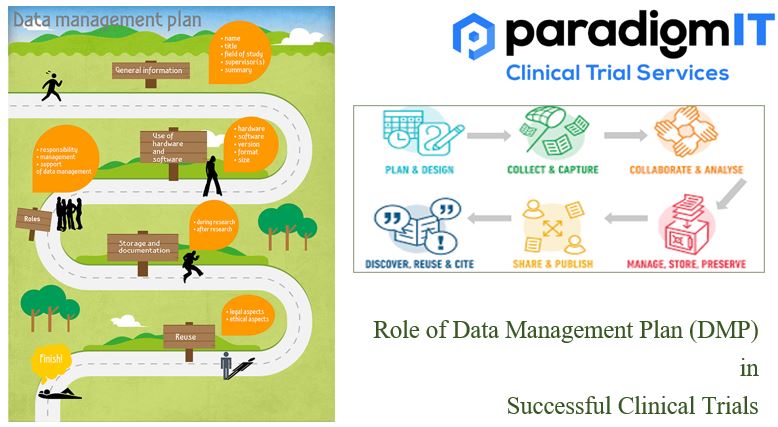Clinical trials are complex and expensive undertakings, and the data collected during them is essential to ensuring their success. A well-written DMP can help to ensure that the data is accurate, complete, and compliant with regulatory requirements.
What is a Data Management Plan (DMP)?
A Data Management Plan (DMP) is a detailed and well-structured document that specifies how data will be gathered, analyzed, stored, and eventually shared during the lifecycle of a clinical study. DMPs serve as a road map for research teams to follow to preserve data integrity, consistency, and regulatory compliance. They are more than simply a formality; they are a strategic framework that adds to the overall success of clinical studies.
Key Sections of DMP:
A successful clinical trial requires an adequate Data Management Plan (DMP). Documents that cross-reference each other, such as the Protocol, SOPs, and Guidelines, ensure that everything is in sync. It is critical to keep the DMP up to date throughout the trial that improves data integrity and trial quality.
- Trial Overview: Summarizes the trial design, objectives, endpoints, and patient population.
- Data Management Strategy: Details the data collection methods and sources, Data flow from collection to database, Data validation and quality control procedures & Handling of missing or discrepant data.
- Data Management Organization: List out the roles and responsibilities of data management team members & Communication and escalation processes.
- Data Collection: Comprises Case report form (CRF) design and structure & Data entry procedures and timelines.
- Data Validation and Quality Control: Precises the edit checks and data validation rules, Query management process & Data reconciliation between different sources. Data reconciliation is integral to ensure data accuracy across sources. Sources might be eCRF, EDC, Labs, Safety data which needs to be integrated, detected, compared, and resolve discrepancies for transparency and compliance. Continuous monitoring ensures consistency throughout the trial.
- Medical Coding: This section specifies the coding process and the dictionaries to be used (e.g., MedDRA, WHODD, CTACE). Describes procedures for coding and mapping clinical terms to standardized codes and outline process for coding and reporting adverse events.
- Risk-Based Data Handling: Explains the identification of potential data risks, Mitigation strategies to address risks & Monitoring plan to ensure data quality.
- Protocol Deviations: Guidance on reporting and documentation procedure for the observed protocol deviations. In additional they are classified on criticality of the impact on trial data.
- Data Handling and Security: Highlights the Data encryption and storage, Data transfer procedures, security measures, and Data anonymization/masking and protection of patient privacy.
- Data Reporting and Analysis: Includes Data cut-off and Database lock procedures, Statistical analysis plan and data reporting timelines & Generation of interim and final reports.
- Data Archiving: Includes the format and storage location for archiving data, team responsible for archiving. Also clarifies the duration the data will be retained post-trial. Details the procedure for accessing and retrieving archived data.
- Document Updates: DMP should be updated during the trial to reflect any changes in the study design, regulatory guidelines, or practical considerations. Updates might be necessary due to unforeseen challenges, new risks, or evolving regulatory requirements. Keeping the DMP up to date ensures that the data management strategy remains aligned with the trial’s goals and objectives, and that any deviations from the original plan are appropriately documented and justified.
Purpose & Significance of DMP:
There are numerous advantages to having a DMP in place. For starters, it can aid in improving the quality of data obtained. A DMP can help to decrease errors and omissions by clearly specifying data collection practices. Second, a DMP can assist in ensuring that the data complies with regulatory obligations. This is critical for clinical trials overseen by regulatory agencies such as the FDA. Third, a DMP can assist in saving time and money. The data management team can be more efficient and productive in their work if they have a clear plan in place.
- Ensuring Data Integrity and Quality
- Enhancing Collaboration and Communication
- Regulatory Compliance and Audit Preparedness
- Streamlining Data Sharing and Transparency
Useful tips for writing a successful DMP:
Creating a solid Data Management Plan (DMP) necessitates a wide range of skills. Collaborate with multidisciplinary teams that include biostatisticians, medical monitors, and programmers. Their contributions help to improve data collecting, quality assurance, and risk management measures. Clear communication fosters alignment, while in-depth insights aid in customized planning. Medical Monitors ensure quality control, while Biostatisticians improve statistical accuracy. Programmers optimize data handling. Real-time trial dynamics-based modifications become possible, ensuring agility. Compliance is ensured by regulatory professionals. Integrating these experts’ recommendations produces a dynamic, adaptive DMP, which improves the trial’s overall success.
Conclusion:
In clinical trials, Data Management Plans (DMPs) are indispensable. They provide structured approaches to data handling, ensuring integrity, collaboration, compliance, and transparency. Embracing DMPs is imperative for credible and successful trials. A well-designed and effectively implemented DMP provides a roadmap for managing data throughout its lifecycle, ensuring data quality, compliance, and successful project outcomes across a wide range of fields and industries.
For more information –
Visit our website – www.paradigmit.com
Or you can write us at ask@paradigmit.com
Follow us for more – https://www.linkedin.com/company/paradigmittechnologyservices/?viewAsMember=true


